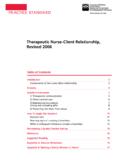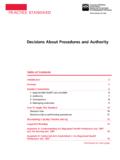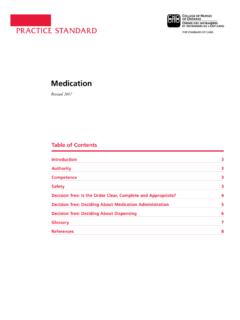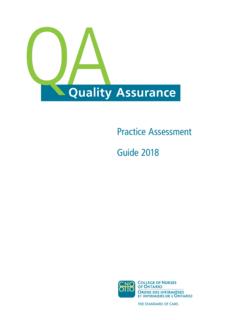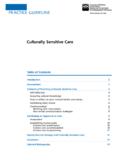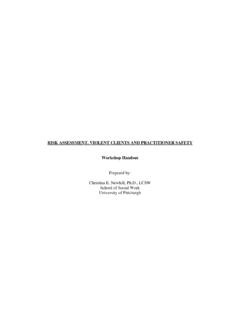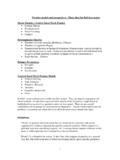Transcription of PRACTICE GIDELINE Conflict Prevention and …
1 PRACTICE GUIDELINET able of Contents Introduction 3 Nurse-Client Conflict 3 Key factors 4 Prevention 4 management 5 Conflict With Colleagues 5 Key factors 5 Prevention 6 management 6 Workplace Conflict 7 Key factors 7 Prevention 8 management 8 Role of Nurses in Formal Leadership Positions 9 Preventing Conflict among staff members 9 Managing Conflict among staff members 9 continued on next pageConflict Prevention and management Table of Contents continuedConflict Prevention and management Pub.
2 No. 47004 ISBN 978-1-77116-062-9 Copyright College of Nurses of Ontario, or for-profit redistribution of this document in part or in whole is prohibited except with the written consent of CNO. This document may be reproduced in part or in whole for personal or educational use without permission, provided that: Due diligence is exercised in ensuring the accuracy of the materials reproduced; CNO is identified as the source; and The reproduction is not represented as an official version of the materials reproduced, nor as having been made in affiliation with, or with the endorsement of, Published January 2000 as Abuse of Nurses (ISBN 0-921127-75-8) Revised for Web June 2003, Reprinted January 2004, December 2005 as Nurse Abuse. Reprinted May 2008, Updated June 2009 (ISBN 1-897308-18-3).
3 Updated February copies of this booklet may be obtained by contacting CNO s Customer Service Centre at 416 928-0900 or toll-free in Canada at 1 800 of Nurses of Ontario 101 Davenport Rd. Toronto, ON M5R fascicule existe en fran ais sous le titre : La pr vention et la gestion des conflits, no 57004 VISION Leading in regulatory excellenceMISSION Regulating nursing in the public interestDebriefing After a Critical Incident 9 Glossary 11 Decision Tree: Withdrawal of Services 12 References 13 Suggested Reading 14 PRACTICE GUIDELINE3 College of Nurses of Ontario PRACTICE Guideline: Conflict Prevention and ManagementIntroductionNursing is a profession that is based on collaborative relationships with clients and colleagues.
4 When two or more people view issues or situations from different perspectives, these relationships can be compromised by Conflict . In this document, Conflict refers to a power struggle in which a person intends to harass, neutralize, injure or eliminate a is commonly perceived as being a negative issue. However, the experience of dealing with Conflict can lead to positive outcomes for nurses,2 their colleagues3 and Conf lict that is managed effectively by nurses can lead to personal and organizational growth. If Conflict is not managed effectively, it can hinder a nurse s ability to provide quality client care5 and escalate into violence and ,7 Because of this, nurses need to be aware of the ways in which Conflict can escalate and be prepared to prevent or manage it in the workplace.
5 While Conflict is an inherent part of nursing,8 the provision of professional services to clients does not include accepting abuse. In addition, Conflict among colleagues can lead to antagonistic and passive-aggressive behaviours (such as bullying or horizontal violence) that compromise the therapeutic nurse-client Nurses who effectively deal with Conflict demonstrate respect for their clients, their colleagues and the that remains unresolved can have far-reaching effects that ultimately influence every aspect of client To protect the public s right to quality nursing services, the College of Nurses of Ontario (the College) is committed to helping nurses recognize and manage Conflict in the PRACTICE setting, and to prevent Conflict from escalating into Conflict Prevention and management PRACTICE guideline replaces the 2004 Nurse Abuse PRACTICE guideline, originally published as Abuse of Nurses in 2000.
6 It is meant as an overview, not as a comprehensive Conflict - management resource. This guideline outlines key factors associated with Conflict with clients, colleagues and in the workplace, and offers strategies for preventing and managing Conflict that has escalated. It also highlights the role of nurses in formal leadership positions, as well as the importance of the debriefing process in the Prevention and management of Conflict . Nurse-Client ConflictThe therapeutic nurse-client relationship is the foundation for providing nursing services that contribute to the client s health and well-being. The role of the nurse in the therapeutic nurse-client relationship is to support the client in achieving the client s health goals. However, unresolved Conflict can impede the attainment of these goals.
7 1 (Sportsman, 2005)2 In this document, the term nurse refers to Registered Practical Nurse (RPN), Registered Nurse (RN) and Nurse Practitioner (NP).3 In this document, the term colleague refers to the individuals nurses work with to deliver client care. These include nurses, physicians, managers, administrators and other members of the health care In this document, the term client refers to an individual, family, group or (Gerardi, 2004)6 (Freshwater, 2000; Kelly, 2006; Gerardi, 2004)7 Bolded words are defined in the glossary on page (Thomas, 1976) 9 Refer to the College s Therapeutic Nurse-Client Relationship, Revised 2006 PRACTICE (Diaz, 1991) PRACTICE GUIDELINE4 College of Nurses of Ontario PRACTICE Guideline: Conflict Prevention and ManagementKey factors It is possible to identify characteristics and situations that are associated with the evolution or escalation of Conflict among nurses, clients and their families.
8 Nurses who know how to recognize key factors associated with Conflict may prevent its escalation and improve the delivery of between a nurse and a client can escalate if a client is:a) intoxicated or withdrawing from a substance-induced state;b) being constrained (for example, not being permitted to smoke) or restrained (for example, with a physical or chemical restraint);c) fatigued or overstimulated; and/ord) tense, anxious, worried, confused, disoriented or between a nurse and a client can escalate if a client has:a) a history of aggressive or violent behaviour, or is acting aggressively or violently (for example, using profane language or assuming an intimidating physical stance);b) a medical or psychiatric condition that causes impaired judgment or an altered cognitive status; c) an active drug or alcohol dependency or addiction;d) difficulty communicating (for example, has aphasia or a language barrier exists); and/ore) ineffective coping skills or an inadequate support between a nurse and a client can escalate if a nurse:a) judges, labels or misunderstands a client; b) uses a threatening tone of voice or body language (for example, speaks loudly or stands too close);c) has expectations based on incorrect perceptions of cultural or other differences;d) does not listen to, understand or respect a client s values, opinions, needs and ethnocultural beliefs.
9 12e) does not listen to the concerns of the family and significant others, and/or act on those concerns when it is appropriate and consistent with the client s wishes;f ) does not provide sufficient health information to satisfy the client or the client s family; and/org) does not reflect on the impact of her/his behaviour and values on the part of the therapeutic nurse-client relationship is providing client-centred care. Nurses can provide client-centred care by following the client s lead about information-giving and decision-making,13 attempting to understand the meaning behind the client s behaviour and using proactive communication strategies that focus fully on the client. Nurses can employ client-centred care strategies to prevent behaviours that contribute to the escalation of can:a) continually seek to understand the client s health care needs and perspectives; 11 (Leather, 2002)12 Refer to the College s Therapeutic Nurse-Client Relationship, Revised 2006 PRACTICE standard and Culturally Sensitive Care PRACTICE guideline.
10 13 (RNAO, 2003) PRACTICE GUIDELINE5 College of Nurses of Ontario PRACTICE Guideline: Conflict Prevention and Managementb) acknowledge the feelings behind the client s behaviour; c) ask open-ended questions to establish the underlying meaning of the client s behaviour;d) engage in active listening (for example, use verbal and nonverbal cues to acknowledge what is being said); e) use open body language to display a calm, respectful and attentive attitude;f ) acknowledge the client s concerns about the health care system and his/her experiences as a client;g) respect and address the client s wishes, concerns, values, priorities and point of view;14h) anticipate Conflict in situations in which it has previously existed and create a plan of care to prevent its escalation; andi) reflect to understand how her/his behaviour and values may negatively affect the are many different strategies for managing Conflict that can be implemented by nurses before Conflict escalates.


